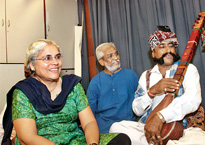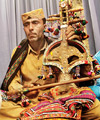
Filmmakers Anjali Monteiro, 56, and KP Jayasankar, 59, say they will not be too surprised if the audience gets a tad restless at first during the screening of their Kachchhi documentary, So Heddan So Hoddan (Like Here Like There) at the NCPA in Mumbai this week.

The film moves at a pace most would consider leisurely, much like its subject, the Fakirani Jatt community in Kachchh, Gujarat. The documentary has 20-second-long-shots, for instance, of a bullock cart crossing the desert or a cicada flitting over a log of wood in the water.
“To capture the mysticism of the Fakirani Jatts, we too shed the usual ‘quick bites’ habit and just let things flow,” says Monteiro. “To film their rhythm, we needed to hold that thought, and our camera too,” adds Jayasankar, sitting beside Monteiro at their Deonar home in suburban Mumbai.
 Before Partition, the Maldhari (pastoral) Fakirani Jatts could move freely across the Great Rann, shuttling between Sindh (which became a part of Pakistan) and Kachchh. Now, the Jatts have been forced to settle and take up other professions. They make a livelihood from farming, driving trucks or working in power looms. But when they find time, they can be seen reminiscing about the teachings of the 17th century Sufi philosopher, Shah Abdul Latif Bhitai, or playing their traditional musical instrument, the surando.
Before Partition, the Maldhari (pastoral) Fakirani Jatts could move freely across the Great Rann, shuttling between Sindh (which became a part of Pakistan) and Kachchh. Now, the Jatts have been forced to settle and take up other professions. They make a livelihood from farming, driving trucks or working in power looms. But when they find time, they can be seen reminiscing about the teachings of the 17th century Sufi philosopher, Shah Abdul Latif Bhitai, or playing their traditional musical instrument, the surando.
Sufi wisdom
Monteiro and Jayasankar, both professors at the Centre for Media and Cultural Studies, Tata Institute of Social Sciences, have won 22 national and international awards for their documentaries over the past 25 years. In their earlier works, the duo have worked with another marginalised Kachchhi community (Do Din Ka Mela), an iconoclastic woman celebrating her womanhood through poems (She Write), transgenders (Our Family) and the creativity of the Yerwada jail prisoners (YCP).
So Heddan… opens with Haji Umar Suleiman, 55, the eldest of three cousins, speaking about his love for the Sufi philosopher Bhitai. Haji remembers how he approached an elderly man at his school and begged him to teach him Bhitai’s Rissalo (his teachings consisting of 36 melodies). “Haji’s wisdom soothes anyone who’ll care to listen. Here is a man, removed from what we call is a civilised world, who doesn’t understand the politics of Partition, but fully well understands suffering, the beauty of diversity and transience,” says Jayasankar.
Monteiro and Jayasankar first heard about the Fakirani Jatt community in 2008 from friends who work at the Kutch Mahila Vikas Sangathan, a Gujarat-based NGO. One of KMVS’s radio shows featured Haji’s cousins, Mustafa Ali Jat and Usman Sonu Jat, who sing and play their 100-year-old peacock-shaped, five-stringed surando. “We fell in love with their folk tales, and decided to explore a life that is so removed from the industrialised, modern Gujarat we know,” says Jayasankar.
The community had mixed feelings about being filmed by Monteiro and Jayasankar when they first went to their village, cameras and sound equipment in tow. The documentary has a scene where Mustafa and his wife, Rahima bai, are preparing lunch and Mustafa speaks of the surando and its heritage. Suddenly, Rahima bai asks Mustafa (in Kachchhi) about the cameras.
“These cameras are easily worth Rs50,000, are they not? And these people want to spend all this money just filming us? Where will this go? How will we ever know in what light they will present us to the world outside?” demands Rahima bai.
Jayasankar says the community’s concerns were not unreasonable. A few years ago, according to Haji, a Fakirani Jatt went to a city in Gujarat and saw photographs of a woman from the community on a tourism brochure. “Someone had probably taken the photograph and sold it to a tourism company as the ‘face of Gujarat’. The Fakirani Jatts are very particular about how their women are portrayed, and didn’t take it too well,” says Jayasankar.
Between past and present
The Jatts gradually became comfortable with Monteiro and Jayasankar when they realised that the documentary was meant to archive their lives — the way they are. “We were quite overwhelmed by the manner in which the community faces drought and disaster with grace and dignity, not as victims. May be it is the vast, barren landscape that makes them humbler and equanimous,” feels Monteiro.
Through the documentary, the filmmaker duo want to explore the paradox in the lives of the community. The Fakirani Jatts are somewhere in the middle of their glorious past and a present they are coming to terms with. But there is a marginalisation of their tradition, which is apparent everywhere. Primary schools in their neighbourhood teach their children bhajans in Gujarati, not Kachchhi, says Monteiro. All posters put up in the school promote a ‘normal way to be’ which is removed from the Fakirani Jatt way of life. The teachers have a fixed agenda to ‘civilise’ the community’s children and shun the idea of incorporating their traditions into their present.
Monteiro and Jayasankar want people to know how the pastoralists are losing many battles — sometimes against the mushrooming power plants, and then against the government who planted the weed, gaando baawal, that destroys their grasslands and their livelihood. And then, in their homes, there is a struggle wherein their children will never go back to the surando and Bhitai’s wisdom, among other things, says Monteiro.
(So Heddan So Hoddan will be screened at the Tata Theatre, NCPA, Mumbai, on Friday, February 17 at 7pm)